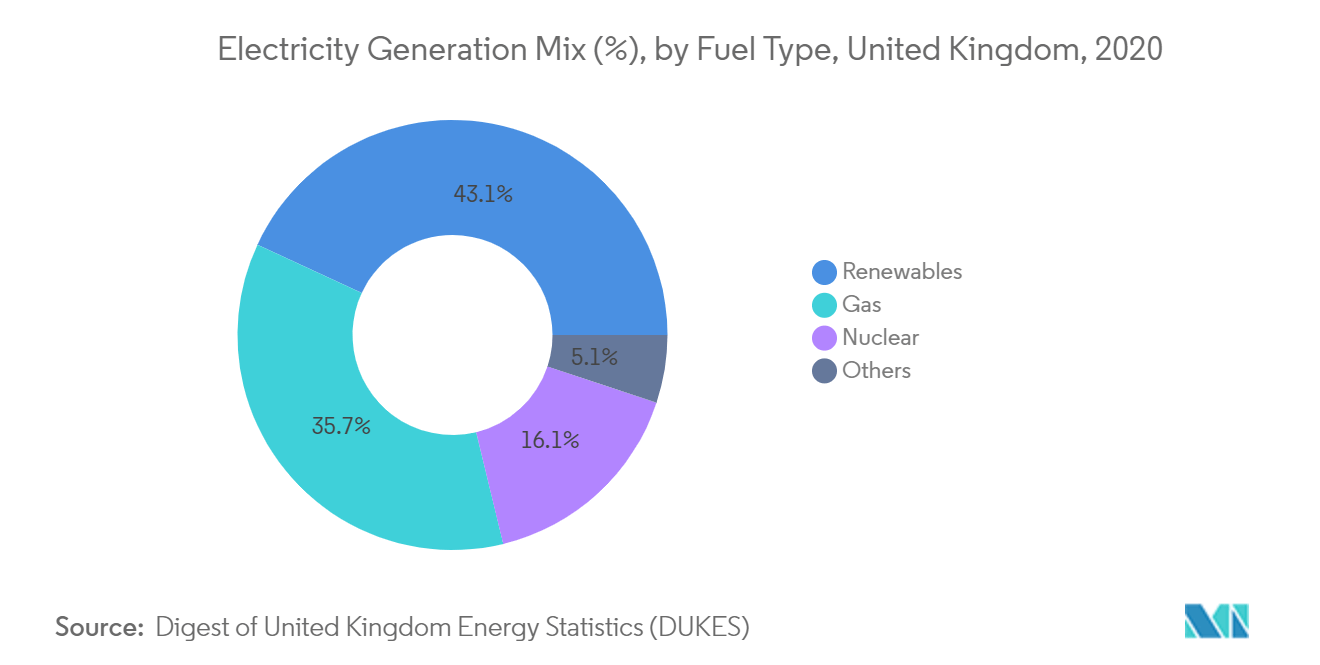Market Trends of United Kingdom Power Industry
This section covers the major market trends shaping the UK Power Market according to our research experts:
Non-hydro Renewable Power Segment to Witness Significant Market Growth
The United Kingdom's non-hydro renewable power generation is majorly driven by wind, solar, and bioenergy sources, accounting for about 42% of the total electricity generation mix, increasing from 36% in 2019.
The total non-hydro renewable power generation increased by 15.1 TWh in 2020 with 13% year-on-year growth. Out of 15.1 TWh, wind energy accounted for about 11.6 TWh (comprising 2.9 TWh of onshore wind and 8.7 TWh of offshore wind energy).
According to the Digest of United Kingdom Energy Statistics 2021, the total non-hydro renewable power installed capacity increased to 45.9 GW in 2020 from 45.0 GW in 2019. It is expected to witness more significant growth during the forecast period.
Furthermore, the United Kingdom aims to generate 100% electricity from clean energy sources by 2035. The goal is expected to be achieved by increasing investments and upcoming non-hydro renewable energy projects.
As of 2020, rooftop solar accounted for approximately 40% of the country's total solar PV installed capacity. Solar PV systems of sizes smaller than 4 kW are majorly deployed as rooftop systems in the residential sector, and systems of sizes between 50 kW and 5 MW are deployed as rooftop and ground-mounted systems in large housing communities, commercial, and industrial (C&I) sectors.
In March 2021, Statkraft, Europe's largest renewable energy generator, announced the development plans for three new solar farms in the United Kingdom, two in Cornwall and one in Suffolk. The solar energy farms aim to provide 125.5 MWp of solar capacity, generate nearly 127 GWh of electricity per year, and power nearly 36,000 homes.
In January 2022, SSE announced details of its first solar project that delivers 30 MW of clean energy as part of its ambitious GBP 12.5 billion investment program to power change toward net-zero. The 30 MW solar farm at Littleton Pastures is located near Evesham, Worcestershire. Once completed in late 2023, the 77-acre site would be capable of powering about 9,400 homes.
Therefore, based on the abovementioned factors, the non-hydro renewable power segment is expected to witness significant demand in the UK power market during the forecast period.

Upcoming and Ongoing Power Projects Expected to Drive Market Demand
The United Kingdom's electricity generation landscape has continued to evolve and move away from fossil fuels to renewable sources. Renewable generation has now reached record levels and contributes a 43% share of electricity generation.
As per the Digest of United Kingdom Energy Statistics 2021, the share of total electricity generation was dominated by renewable energy with 43%, followed by natural gas with 35.7%, and nuclear with 16.1% in 2020. This was due to increased power projects across the country over the years and is expected to witness the same growth rate during the forecast period.
In February 2021, the UK government auctioned new projects with large firms like BP participating. A total of six projects, representing just under 8 gigawatts (GW) of capacity, were successful in the auction. If commenced, they could provide enough electricity to power about 7 million homes.
In January 2022, the UK government announced funding to build floating offshore wind ports and factories in Scotland and Wales. Floating offshore wind projects will receive investments of more than GBP 60 million from the public and private sectors to develop new technologies.
Also, in January 2022, the UK government announced GBP 100 million (USD 134 million) funding to support the Sizewell C nuclear power project in Suffolk. The funding will be used to continue the development of the project to attract further financing from private investors and secure relevant approvals.
Therefore, based on the abovementioned factors, upcoming and ongoing power projects across the country are expected to drive the power market during the forecast period.


